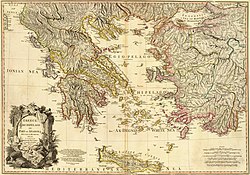
Back الجمهورية اليونانية الثانية Arabic Segunda República Helénica AST İkinci Yunanıstan Respublikası Azerbaijani Втора гръцка република Bulgarian Segona República Hel·lènica Catalan Druhá Helénská republika Czech Anden græske republik Danish Zweite Hellenische Republik German Β΄ Ελληνική Δημοκρατία Greek Dua Greka Respubliko Esperanto
Hellenic Republic Ἑλληνικὴ Δημοκρατία | |||||||||
|---|---|---|---|---|---|---|---|---|---|
| 1924–1935 | |||||||||
| Anthem: «Ύμνος εις την Ελευθερίαν» Ýmnos eis tin Eleftherían "Hymn to Liberty" | |||||||||
 The Hellenic Republic in 1935 | |||||||||
| Capital | Athens | ||||||||
| Common languages | Greek (Katharevousa had official status, while Demotic was popular) | ||||||||
| Religion | Eastern Orthodox Church | ||||||||
| Demonym(s) | Greek, Hellene | ||||||||
| Government | Unitary parliamentary republic (1924–1925; 1926–1936) Unitary parliamentary republic under military dictatorship (1925–1926) | ||||||||
| President | |||||||||
• 1924–1926 | Pavlos Kountouriotis | ||||||||
• 1926 | Theodoros Pangalos | ||||||||
• 1926–1929 | Pavlos Kountouriotis | ||||||||
• 1929–1935 | Alexandros Zaimis | ||||||||
| Prime Minister | |||||||||
• 1924 (first) | Alexandros Papanastasiou | ||||||||
• 1933–1935 (last) | Panagis Tsaldaris | ||||||||
| Legislature | Parliament | ||||||||
• Upper house | Senate | ||||||||
• Lower house | Chamber of Deputies | ||||||||
| Historical era | Interwar period | ||||||||
• Established | 25 March 1924 | ||||||||
• Abolished | 3 November 1935 | ||||||||
| Area | |||||||||
| 130,199 km2 (50,270 sq mi) | |||||||||
| Population | |||||||||
• 1924[1] | 5,924,000 | ||||||||
• 1928 (census)[1] | 6,204,684 | ||||||||
• 1935[1] | 6,839,000 | ||||||||
| Currency | Greek drachma | ||||||||
| |||||||||
| Today part of | |||||||||
The Second Hellenic Republic is a modern historiographical term used to refer to the Greek state during a period of republican governance between 1924 and 1935. To its contemporaries it was known officially as the Hellenic Republic (Greek: Ἑλληνικὴ Δημοκρατία [eliniˈci ðimokraˈti.a]) or more commonly as Greece (Greek: Ἑλλάς [eˈlas], Hellas). It occupied virtually the coterminous territory of modern Greece (with the exception of the Dodecanese) and bordered Albania, Yugoslavia, Bulgaria, Turkey and the Italian Aegean Islands. The term Second Republic is used to differentiate it from the First and Third republics.
The fall of the monarchy was proclaimed by the country's parliament on 25 March 1924.[2] A relatively small country with a population of 6.2 million in 1928, it covered a total area of 130,199 km2 (50,270 sq mi). Over its eleven-year history, the Second Republic saw some of the most important historical events in modern Greek history emerge; from Greece's first military dictatorship, to the short-lived democratic form of governance that followed, the normalisation of Greco-Turkish relations which lasted until the 1950s, and to the first successful efforts to significantly industrialise the nation.
The Second Hellenic Republic was abolished on 10 October 1935,[3] with its abolition being confirmed by referendum on 3 November; this referendum was widely believed to have been mired with electoral fraud. The fall of the Republic eventually paved the way for Greece to become a totalitarian single-party state,[4] when Ioannis Metaxas established the 4th of August Regime in 1936, lasting until the Axis occupation of Greece in 1941.
| History of Greece |
|---|
 |
|
|
- ^ a b c Statistical Yearbook of Greece–1936, p. 416.
- ^ Cite error: The named reference
FEK64was invoked but never defined (see the help page). - ^ "Newspaper of the Government – Issue 456". Government Newspaper of the Kingdom of Greece. 10 October 1935. Retrieved 18 August 2012.
- ^ "Metaxism". www.populismstudies.org. European Center for Populism Studies. Archived from the original on 14 July 2024. Retrieved 5 October 2024.
Although the Metaxas government and its official doctrines are often described as fascist, academically it is considered to have been a conventional totalitarian-conservative dictatorship akin to Francisco Franco's Spain or António de Oliveira Salazar's Portugal.

